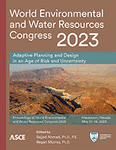Developing Green Stormwater Infrastructure Strategies to Reduce Flood Runoff and Improve Water Quality for the Vulnerable Coastal Communities of Houston
Publication: World Environmental and Water Resources Congress 2023
ABSTRACT
Flooding in highly urbanized coastal communities leaves an adverse impact on socially vulnerable populations as they receive fewer benefits from emerging flood reduction strategies. Green stormwater infrastructure (GSI) can be a sustainable flood resilience approach for vulnerable communities as it can provide nature-based solutions to reduce flood depths and improve runoff water quality. This ongoing study aims at planning GSI strategies and evaluating their performance in the vulnerable communities in the coastal city of Houston, Texas, to mitigate the existing flood risk. Flood exposure in the Kashmere Gardens and Trinity/Houston Gardens neighborhoods of Houston is undeniably higher because of years of environmental injustice, inadequate stormwater infrastructure, non-strategic local planning, and anticipated sea-level rise due to climate change. In addition, releasing untreated industrial wastes into flooding water has given rise to water quality concerns as the toxic chemicals in the flood water enter Galveston Bay downstream through Hunting Bayou posing a severe threat to the fisheries. The potential of a range of GSI practices, including bio-retention cells, permeable pavements, green roofs, rain barrels, etc., are being evaluated using the Storm Water Management Model (SWMM) for the critical sites near the Hunting Bayou in terms of lowering the runoff quantity and pollutant loading for continuous simulation. Results reveal that multiple GSIs within a site perform better than a single low-impact development option. The study results will assist policymakers and other stakeholders to understand the real-time impact of GSI measures and make informed decisions and investments to solve flooding issues in the Gardens neighborhoods.
Get full access to this article
View all available purchase options and get full access to this chapter.
REFERENCES
Ahiablame, L., and Shakya, R. (2018). Modeling flood reduction effects of low impact development at a watershed scale. Journal of Environmental Management. Apr;171:81–91. https://doi.org/10.1016/j.jenvman.2016.01.036. 26878221.
Bond, J., Batchabani, E., Fuamba, M., Courchesne, D., and Trudel, G. (2021). Modeling a Bio-retention Basin and Vegetated Swale with a Trapezoidal Cross Section using SWMM GSI Controls. Journal of Water Management Modeling. https://doi.org/10.14796/JWMM.C474.
Evans, K. (2021). Green Infrastructure Site Suitability Analysis for Wyandotte County and Kansas City, Kansas. https://doi.org/10.17615/nw3f-3y81.
Gülbaz, S., and Kazezyılmaz-Alhan, C. M. (2018). Impact of GSI Implementation on Water Quality in Alibeyköy Watershed in Istanbul, Turkey. Environ. Process. 5 (Suppl 1), 201–212. https://doi.org/10.1007/s40710-018-0318-3.
Kim, H., and Park, Y. (2016). Urban green infrastructure and local flooding: The impact of landscape patterns on peak runoff in four Texas MSAs. Applied Geography. 77. 72–81. https://doi.org/10.1016/j.apgeog.2016.10.008.
Kourtis, I. M., Tsihrintzis, V. A., and Baltas, E. (2018). Simulation of Low Impact Development (GSI) Practices and Comparison with Conventional Drainage Solutions. Proceedings. https://doi.org/10.3390/proceedings2110640.
Liu, Y., Ahiablame, L. M., Bralts, V. F., and Engel, B. A. (2015). Enhancing a rainfall-runoff model to assess the impacts of BMPs and GSI practices on storm runoff. Journal of Environmental Management. 2015 Jan;147:12–23. DOI: https://doi.org/10.1016/j.jenvman.2014.09.005. 25261748.
Martínez Cano, C., Sanchez Torres, A., Galindo, R., Mulugeta, A., Vojinovic, Z., and Galvis-Castaño, A. (2018). Configuring Green Infrastructure for Urban Runoff and Pollutant Reduction Using an Optimal Number of Units. Water. 10. 1528. https://doi.org/10.3390/w10111528.
Pallathadka, A., Sauer, J., Chang, H., and Grimm, N. B. (2022). Urban flood risk and green infrastructure: Who is exposed to risk and who benefits from investment? A case study of three U.S. Cities. Landscape and Urban Planning, 223, [104417]. https://doi.org/10.1016/j.landurbplan.2022.104417.
Pervaiz, F., and Hummel, M. (2022). Evaluation of Climate Change and Urbanization Impacts on Bridges in Harris County, Texas. World Environmental and Water Resources Congress 2022 (pp. 499–507).
Rech, A., Pacheco, E., Caprario, J., Rech, J. C., and Finotti, A. R. (2022). Low-Impact Development (GSI) in Coastal Watersheds: Infiltration Swale Pollutant Transfer in Transitional Tropical/Subtropical Climates. Water; 14(2):238. https://doi.org/10.3390/w14020238.
Sparkman, S., Hogan, D. M., Hopkins, K. G., and Loperfido, J. V. (2017). Modeling Watershed‐Scale Impacts of Stormwater Management with Traditional versus Low Impact Development Design. JAWRA Journal of the American Water Resources Association, 53, 1081–1094.
Tu, M.-C., and Smith, P. (2018). Modeling Pollutant Buildup and Washoff Parameters for SWMM Based on Land Use in a Semiarid Urban Watershed. Water, Air, & Soil Pollution. 229. https://doi.org/10.1007/s11270-018-3777-2.
Wang, H. W., Zhai, Y. J., Wei, Y. Y., and Mao, Y. F. (2019). Evaluation of the effects of low-impact development practices under different rainy types: case of Fuxing Island Park, Shanghai, China. Environ Sci Pollut Res 26, 6706–6716 (2019). https://doi.org/10.1007/s11356-019-04129-x.
Woodruff, S., Tran, T., Lee, J., Wilkins, C., Newman, G., Ndubisi, F., and Van Zandt, S. (2020). Green infrastructure in comprehensive plans in coastal Texas. Journal of Environmental Planning and Management. 64. https://doi.org/10.1080/09640568.2020.1835618.
Yang, Y., and Chui, T. F. M. (2018). Optimizing surface and contributing areas of bio-retentioncells for stormwater runoff quality and quantity management. Journal of Environmental Management. 206. 1090–1103. https://doi.org/10.1016/j.jenvman.2017.11.064.
Information & Authors
Information
Published In
History
Published online: May 18, 2023
ASCE Technical Topics:
- Business management
- Environmental engineering
- Floods
- Hydrologic engineering
- Hydrology
- Infrastructure
- Infrastructure vulnerability
- Practice and Profession
- Runoff
- Sea water
- Stormwater management
- Sustainable development
- Urban and regional development
- Urban areas
- Water (by type)
- Water and water resources
- Water management
- Water quality
- Water treatment
Authors
Metrics & Citations
Metrics
Citations
Download citation
If you have the appropriate software installed, you can download article citation data to the citation manager of your choice. Simply select your manager software from the list below and click Download.
